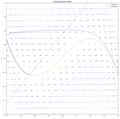FitzHugh–Nagumo model
FitzHugh–Nagumo model is a simplified version of the Hodgkin–Huxley model used to describe the electrical activity of a single neuron. It was proposed independently by Richard FitzHugh in 1961 and by J. Nagumo and his colleagues in 1962 as a two-dimensional model to explain how action potentials in neurons are initiated and propagated. The model captures the essential features of excitability that can be found in nerve cell membranes and is widely used in neuroscience and biophysics for theoretical studies of neuronal dynamics.
Overview
The FitzHugh–Nagumo model simplifies the complex four-variable Hodgkin–Huxley model into a two-variable system that describes the interaction between a neuron's membrane potential and a recovery variable. The model equations are given by:
\[ \begin{align} \frac{dv}{dt} &= v - \frac{v^3}{3} - w + I \\ \frac{dw}{dt} &= \epsilon(v + a - bw) \end{align} \]
where \(v\) represents the membrane potential, \(w\) is the recovery variable, \(I\) is the external current, and \(\epsilon\), \(a\), and \(b\) are parameters that can be adjusted to mimic different types of neuronal behavior. The term \(v - \frac{v^3}{3}\) represents a cubic nonlinearity that is crucial for the generation of action potentials, while the recovery variable \(w\) provides feedback that controls the timing of these events.
Applications
The FitzHugh–Nagumo model is used in various fields of neuroscience and biophysics to study the qualitative behavior of excitable systems. It serves as a fundamental model for understanding the mechanisms of action potential initiation and propagation in neurons. Additionally, it has been applied in the study of cardiac tissue to model the electrical activity of heart cells and in the analysis of pattern formation in spatially extended systems.
Mathematical Analysis
The FitzHugh–Nagumo model is an example of a dynamical system that can exhibit a wide range of behaviors, including fixed points, limit cycles, and bifurcations, depending on the values of its parameters. The model can undergo a Hopf bifurcation, leading to oscillatory behavior that mimics the repetitive firing of neurons. Mathematical analysis of the model helps in understanding how the properties of the system change as parameters are varied, providing insights into the mechanisms of neuronal excitability and the conditions under which abnormal rhythms such as arrhythmias may arise.
Limitations
While the FitzHugh–Nagumo model captures the essential features of neuronal excitability, it is a simplification of the more detailed Hodgkin–Huxley model and thus may not accurately represent all aspects of neuronal dynamics. The model's simplicity, however, makes it a valuable tool for theoretical studies and educational purposes, offering insights into the complex behavior of excitable cells with a more tractable mathematical framework.
See Also
This article is a neuroscience stub. You can help WikiMD by expanding it!
This article is a biophysics-related stub. You can help WikiMD by expanding it!
Transform your life with W8MD's budget GLP-1 injections from $125.
W8MD offers a medical weight loss program to lose weight in Philadelphia. Our physician-supervised medical weight loss provides:
- Most insurances accepted or discounted self-pay rates. We will obtain insurance prior authorizations if needed.
- Generic GLP1 weight loss injections from $125 for the starting dose.
- Also offer prescription weight loss medications including Phentermine, Qsymia, Diethylpropion, Contrave etc.
NYC weight loss doctor appointments
Start your NYC weight loss journey today at our NYC medical weight loss and Philadelphia medical weight loss clinics.
- Call 718-946-5500 to lose weight in NYC or for medical weight loss in Philadelphia 215-676-2334.
- Tags:NYC medical weight loss, Philadelphia lose weight Zepbound NYC, Budget GLP1 weight loss injections, Wegovy Philadelphia, Wegovy NYC, Philadelphia medical weight loss, Brookly weight loss and Wegovy NYC
|
WikiMD's Wellness Encyclopedia |
| Let Food Be Thy Medicine Medicine Thy Food - Hippocrates |
Medical Disclaimer: WikiMD is not a substitute for professional medical advice. The information on WikiMD is provided as an information resource only, may be incorrect, outdated or misleading, and is not to be used or relied on for any diagnostic or treatment purposes. Please consult your health care provider before making any healthcare decisions or for guidance about a specific medical condition. WikiMD expressly disclaims responsibility, and shall have no liability, for any damages, loss, injury, or liability whatsoever suffered as a result of your reliance on the information contained in this site. By visiting this site you agree to the foregoing terms and conditions, which may from time to time be changed or supplemented by WikiMD. If you do not agree to the foregoing terms and conditions, you should not enter or use this site. See full disclaimer.
Credits:Most images are courtesy of Wikimedia commons, and templates, categories Wikipedia, licensed under CC BY SA or similar.
Translate this page: - East Asian
中文,
日本,
한국어,
South Asian
हिन्दी,
தமிழ்,
తెలుగు,
Urdu,
ಕನ್ನಡ,
Southeast Asian
Indonesian,
Vietnamese,
Thai,
မြန်မာဘာသာ,
বাংলা
European
español,
Deutsch,
français,
Greek,
português do Brasil,
polski,
română,
русский,
Nederlands,
norsk,
svenska,
suomi,
Italian
Middle Eastern & African
عربى,
Turkish,
Persian,
Hebrew,
Afrikaans,
isiZulu,
Kiswahili,
Other
Bulgarian,
Hungarian,
Czech,
Swedish,
മലയാളം,
मराठी,
ਪੰਜਾਬੀ,
ગુજરાતી,
Portuguese,
Ukrainian
Contributors: Prab R. Tumpati, MD








